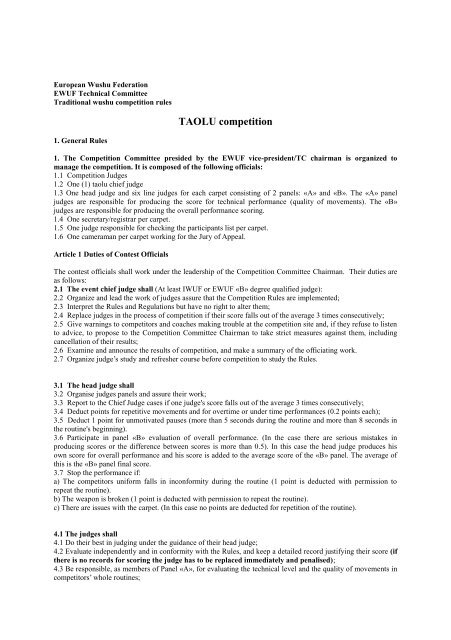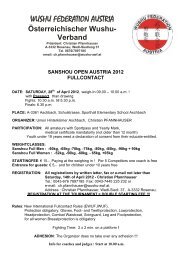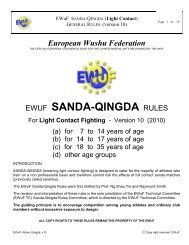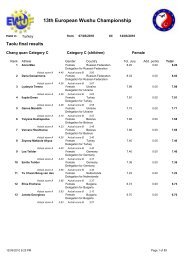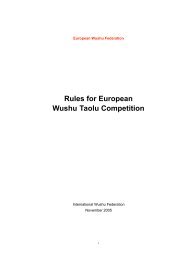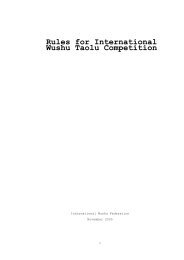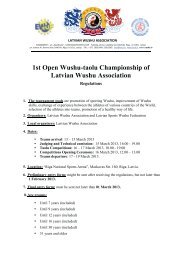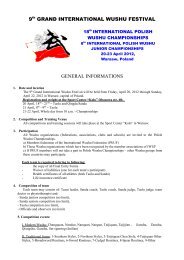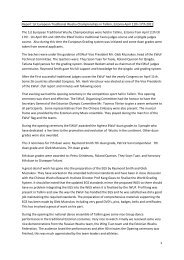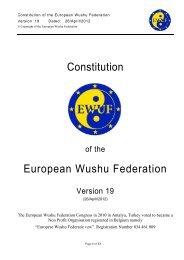Taolu Competition Rules - European Wushu Federation
Taolu Competition Rules - European Wushu Federation
Taolu Competition Rules - European Wushu Federation
- No tags were found...
You also want an ePaper? Increase the reach of your titles
YUMPU automatically turns print PDFs into web optimized ePapers that Google loves.
<strong>European</strong> <strong>Wushu</strong> <strong>Federation</strong><br />
EWUF Technical Committee<br />
Traditional wushu competition rules<br />
TAOLU competition<br />
1. General <strong>Rules</strong><br />
1. The <strong>Competition</strong> Committee presided by the EWUF vice-president/TC chairman is organized to<br />
manage the competition. It is composed of the following officials:<br />
1.1 <strong>Competition</strong> Judges<br />
1.2 One (1) taolu chief judge<br />
1.3 One head judge and six line judges for each carpet consisting of 2 panels: «A» and «B». The «A» panel<br />
judges are responsible for producing the score for technical performance (quality of movements). The «B»<br />
judges are responsible for producing the overall performance scoring.<br />
1.4 One secretary/registrar per carpet.<br />
1.5 One judge responsible for checking the participants list per carpet.<br />
1.6 One cameraman per carpet working for the Jury of Appeal.<br />
Article 1 Duties of Contest Officials<br />
The contest officials shall work under the leadership of the <strong>Competition</strong> Committee Chairman. Their duties are<br />
as follows:<br />
2.1 The event chief judge shall (At least IWUF or EWUF «B» degree qualified judge):<br />
2.2 Organize and lead the work of judges assure that the <strong>Competition</strong> <strong>Rules</strong> are implemented;<br />
2.3 Interpret the <strong>Rules</strong> and Regulations but have no right to alter them;<br />
2.4 Replace judges in the process of competition if their score falls out of the average 3 times consecutively;<br />
2.5 Give warnings to competitors and coaches making trouble at the competition site and, if they refuse to listen<br />
to advice, to propose to the <strong>Competition</strong> Committee Chairman to take strict measures against them, including<br />
cancellation of their results;<br />
2.6 Examine and announce the results of competition, and make a summary of the officiating work.<br />
2.7 Organize judge’s study and refresher course before competition to study the <strong>Rules</strong>.<br />
3.1 The head judge shall<br />
3.2 Organise judges panels and assure their work;<br />
3.3 Report to the Chief Judge cases if one judge's score falls out of the average 3 times consecutively;<br />
3.4 Deduct points for repetitive movements and for overtime or under time performances (0.2 points each);<br />
3.5 Deduct 1 point for unmotivated pauses (more than 5 seconds during the routine and more than 8 seconds in<br />
the routine's beginning).<br />
3.6 Participate in panel «B» evaluation of overall performance. (In the case there are serious mistakes in<br />
producing scores or the difference between scores is more than 0.5). In this case the head judge produces his<br />
own score for overall performance and his score is added to the average score of the «B» panel. The average of<br />
this is the «B» panel final score.<br />
3.7 Stop the performance if:<br />
a) The competitors uniform falls in inconformity during the routine (1 point is deducted with permission to<br />
repeat the routine).<br />
b) The weapon is broken (1 point is deducted with permission to repeat the routine).<br />
c) There are issues with the carpet. (In this case no points are deducted for repetition of the routine).<br />
4.1 The judges shall<br />
4.1 Do their best in judging under the guidance of their head judge;<br />
4.2 Evaluate independently and in conformity with the <strong>Rules</strong>, and keep a detailed record justifying their score (if<br />
there is no records for scoring the judge has to be replaced immediately and penalised);<br />
4.3 Be responsible, as members of Panel «A», for evaluating the technical level and the quality of movements in<br />
competitors’ whole routines;
4.4 Be responsible, as members of Panel «B», for evaluating the overall performance of competitors’ whole<br />
routines.<br />
4.6 The secretary/registrar shall be responsible for starting and final protocols during the event.<br />
4.7 The judge responsible for checking the participants list shall be responsible for checking the participants 30<br />
minutes before competition, lead them onto the carpet and give the head judges the final participant's list.<br />
5.1 The cameramen shall record all the competition events;<br />
5.2 Replay videotapes at the request of the Head judge or the Jury of Appeal and at the end of competition give<br />
all the materials to the <strong>Competition</strong> Committee Chairman without making any copy.<br />
5.3 Only the official video recording can be used as reference in appeal.<br />
2. General <strong>Rules</strong> for <strong>Competition</strong><br />
Article 1<br />
Types of <strong>Competition</strong><br />
6.1 The <strong>Competition</strong> may be divided into:<br />
6.1.1 Individual competition;<br />
6.1.2 Team competition;<br />
6.1.3 Individual/team competition.<br />
6.2 The <strong>Competition</strong> may be divided into<br />
6.2.1 Senior competition;<br />
6.2.2 Junior competition;<br />
6.2.3 Children’s competition.<br />
Article 2<br />
<strong>Competition</strong> Events<br />
Group 1.<br />
Traditional Taijiquan 传 统 太 极 拳 , 器 械 , 对 练 , 推 手 比 赛<br />
Traditional taijiquan including Chen, Yang, Sun, Wu, Wu(Hao), Li, Wudang, Zhaobao and other traditional<br />
taijiquan styles divided into Taijiquan, Taiji qixie (taiji weapons), Taiji duilian (set-sparring) and Taijituishou<br />
(push hands) competition.<br />
Note: 24, 48, 88, 42 and other single modern routines are not to be used. Modern taiji duilian forms are allowed<br />
provided that they keep in conformity with original style. Time limit for quanshu, qixie and duilian routines – 5<br />
minutes.<br />
Group 2.<br />
Traditional Bagua, Xingyi, Bajiquan 传 统 八 卦 , 形 意 , 八 级 拳 , 器 械 , 对 练 比 赛<br />
Traditional Bagua, Xingyi, Bajiquan styles divided into quanshu, qixie (weapons), duilian (set-sparring)<br />
competition. Time limit for quanshu, qixie and duilian routines – 2 minutes.<br />
Group 3.<br />
Traditional Nanquan 传 统 南 拳 , 器 械 , 对 练 比 赛<br />
Traditional Guandong, Fujian, Sichuan etc. Nanquan schools (Hong, Li, Mo, Cailifo etc. except Yongchun<br />
(Wing Chun) and imitation routines ( 象 形 拳 ), divided into quanshu, qixie (weapons), duilian (set-sparring)<br />
competition. Time limit for quanshu, qixie and duilian routines – 2 minutes.<br />
Group 4.<br />
Traditional Shaolinquan 传 统 少 林 拳 , 器 械 , 对 练 比 赛<br />
Traditional Songshan shaolingquan divided into quanshu, qixie (weapons), duilian (set-sparring) competition.<br />
Time limit for quanshu, qixie and duilian routines – 2 minutes.<br />
Group 5.<br />
Imitation styles 象 形 拳 , 器 械 , 对 练 比 赛
All imitation routines including Houquan, Yinzhuaquan, Zuiquan, Tanglangquan, Ditangquan, Zonghequan,<br />
Minghequan, Heihuquan etc. divided into quanshu, qixie (weapons), duilian (set-sparring) competition. Time<br />
limit for quanshu, qixie and duilian routines – 2 minutes.<br />
Group 6.<br />
Traditional tongbei, fanzi, chuojiao, pigua styles 传 统 通 背 , 翻 子 , 戳 脚 , 劈 挂 拳 , 器 械 , 对 练 比 赛<br />
Traditional tongbei, fanzi, chuojiao, pigua styles divided into quanshu, qixie (weapons), duilian (set-sparring)<br />
competition. Time limit for quanshu, qixie and duilian routines – 2 minutes.<br />
Group 7.<br />
Traditional Yongchun (Wing chun) 传 统 永 春 白 鹤 拳 , 器 械 , 对 练 比 赛<br />
Traditional Yongchun (Wingchun) quanshu routines 彪 指 (biaozhi) and 尋 橋 (xunqiao),<br />
Weapons routines 六 點 半 棍 (liu dian ban gun) 蝴 蝶 雙 刀 (hudie shuang dao) and wooden dummy routines are<br />
allowed. Self composed set-sparring is allowed based on wing chun techniques. Time limit for duilian routines –<br />
2 minutes.<br />
Group 8.<br />
Other traditional styles 其 他 拳 术 , 器 械 , 对 练 比 赛<br />
All other traditional quanshu and weapons routines: chaquan, huaquan, baoquan, baimei (pakmei), liuhequan,<br />
gongliquan, yuejiaquan, wudangquan (except wudang taijiquan, xingyiquan and baguaquan which belong to<br />
above-mentioned categories) etc. Not belonging to previous categories; traditional weapons (single, double,<br />
flexible) not belonging to previous weapon categories. Self composed set-sparring is allowed based on those<br />
techniques. Time limit for quanshu, qixie and duilian routines – 2 minutes.<br />
Not allowed in competition.<br />
1. All standard and optional IWUF competition routines including modern duilian;<br />
2. Difficulty movements (except those present in the routines traditionally – i.e. quedilong in Chen taijiquan,<br />
cekongfan in Huaquan, martial acrobatics in imitation styles).<br />
3. Mulanquan routines.<br />
4. All vietvodao, vovinam and other Vietnamese styles.<br />
5. Shorinji kempo, Taikiken and other Japanese derivates.<br />
6. Penchak silat, sikaran, kuntao, panatukan and other Malaysian, Indonesian, Thai and Pilipino arts.<br />
7. Qigong routines.<br />
8. All self-composed routines except duilian, imitation styles and weapons (weapons anyway should be<br />
traditional and used principles clearly belonging to historical schools and styles of wushu (i.e. Chunqiu dadao,<br />
Guandao, Hudie shuangdao etc.).<br />
The criteria of determination of routines and schools authenticity shall be the «Encyclopaedia of Chinese<br />
<strong>Wushu</strong>» ( 中 国 武 术 百 科 全 书 出 版 社 1998 北 京 ) compiled by the Chinese <strong>Wushu</strong> Association and <strong>Wushu</strong><br />
research Institute.<br />
Time limitation is applied on the «stop after time limit» principle. That means that if your routine has 2 minutes<br />
time limitation, at 1 min. 54/56 sec. You should perform an appropriate closing form (shoushi) and finish it.<br />
The principle of grouping and dividing styles.<br />
To avoid fake competition and encourage participation, the principle of «groups with no less than six<br />
competitors in group shall be implemented». That means, that 3 shall get medals, and 3 shall remain without.<br />
If there is less than six competitors in the group, they are added to another group which is the closest. (i.e. chen<br />
taijiquan and zhaobao taijiquan can be mixed together, yang taijiquan and li taijiquan, sun taijiquan and wu<br />
taijiquan, etc.)<br />
In case of weapons the same principle shall be applied (i.e. taiji dao competitor can be mixed with taiji jian<br />
group).<br />
The inverse is applied if there are too much competitors in a group (more than 18). They shall be, in this case<br />
split according relevant principles (i.e. in nanquan event, Guandong and Fujian routines can be split into two<br />
separate groups with separate awarding in this case). If the splitting makes unequal groups (i.e. 5 and 13<br />
competitors, the required number of competitors from the second group shall be added to the other to obtain the<br />
number of six – 6 – 12).<br />
The competition committee shall do the correct grouping after the guidance of its Chairman.
Article 3<br />
Age groups in <strong>Competition</strong><br />
8.1 Adult: full age of 18 and above up to 50 years old (up to 65 years old for traditional taijiquan only).<br />
8.2 Junior: from 12 to 18<br />
8.3 Children: under 12<br />
Article 4<br />
Appeals<br />
9.1 Scope of appeals<br />
The Jury of Appeal shall handle appeals submitted by a representative of a participating team, which disagrees<br />
with deductions made by the head judge or with Panel «B»’s judgment against competitors of the team in the<br />
process of competition.<br />
9.2 Procedures & requirements for appeals<br />
If a participating team disagrees with the judge’s decisions against its members, the appeal shall be submitted by<br />
the team leader or coach in written form to the Jury of Appeal within 15 minutes after the conclusion of the event<br />
concerned, together with an appeal fee of Euro 100. Each appeal is limited to one issue.<br />
The Jury of Appeal shall examine the case through videotapes. If the judgment made by the jury proves to be<br />
correct, the appealing team shall abide by it. If any trouble-making is caused by disobedience, the Jury of Appeal<br />
may, according to the severity of the case, propose to the EWUF Technical Committee to take strict measures,<br />
including cancellation of the competition results. If the judgment made by the jury proves to be wrong, the Jury<br />
of Appeal shall propose to the EWUF Technical Committee to take measures, in accordance with regulations<br />
concerned, against the wrong judgment. The appeal fee shall be returned. The original results can be changed in<br />
this case. The decision of the Jury of Appeal is final. Sanctions are to be applied for non-sportive behaviour.<br />
Article 5<br />
Determination of the Starting Order of <strong>Competition</strong><br />
The starting order of competition for each event shall be determined by drawing lots conducted under the<br />
supervision of the <strong>Competition</strong> Committee and the chief referee. If both preliminaries and finals are held, the<br />
starting order in the finals shall be determined by the results of the preliminaries, with the lowest scorer<br />
appearing first and the highest scorer appearing last. In case of a tie in the preliminaries, the starting order shall<br />
be determined by drawing lots.<br />
Article 6<br />
Registry<br />
Competitors shall arrive at the designated place 30 minutes prior to the competition for the first roll-call and for<br />
an inspection of the costume and apparatus. The second roll-call will take place 20 minutes, and the third rollcall<br />
10 minutes, before the competition starts.<br />
Article 7<br />
Protocol<br />
At the roll-call and the announcement of final scores, the competitors should give the head judge a fist-palm<br />
salute.<br />
Article 8<br />
Timekeeping<br />
Timekeeping shall start when the competitor begins his performance from a stationary position and stop when<br />
his whole routine ends in a standing position with feet together (heels touching each other).<br />
Article 9<br />
Display of Scores<br />
The competitors’ scores shall be displayed to the public.<br />
Article 10 Default<br />
Any failure to come in time for registry and competition shall be treated as default.<br />
Article 11 Placing<br />
11.1 Placing in individual(including duilian)competition
Competitors in individual events shall be placed according to their scores, with the best scorer placed first, the<br />
second best scorer placed second, and so on and so forth.<br />
11.2 Placing in individual all-around competition<br />
Competitors in the individual all-around event shall be placed according to their total scores or to specific<br />
methods provided in the Regulations, with the best scorer placed first, the second best scorer placed second, and<br />
so on and so forth.<br />
11.3 Placing in group events<br />
The group with the best score shall be placed first, the group with the second best score placed second, and so on<br />
and so forth.<br />
11.4 Team placing<br />
Teams shall be placed according to methods provided in the Regulations of competition.<br />
11.5 Tied Scores<br />
11.6 Tied scores in individual events shall be solved in the following ways:<br />
11.7 The competitor with a higher score for overall performance shall be placed higher;<br />
11.8 If the tie remains, the competitor with a lower deduction of points for overall performance shall be placed<br />
higher;<br />
11.9 If the tie remains, the tied competitors shall share the place.<br />
11.10 In competitions with preliminaries and finals, the competitor with better results in the preliminaries shall<br />
be placed higher. If the tie remains, the placing in the finals shall be determined as provided in the above<br />
paragraphs.<br />
11.11 In the individual all-around event, the competitor who ranks first in more individual events shall be placed<br />
higher. If the tie remains, the competitor who ranks second in more individual events shall be placed higher, and<br />
so on and so forth. In case of an equal number of places in all individual events, the tied competitors shall share<br />
the place.<br />
11.12 In the team total points, the team which has more points in individual events shall be placed higher. If the<br />
tie remains, the team with more second places in individual events shall be placed higher, and so on and so forth.<br />
In case of an equal number of places in all individual events, the tied teams shall share the place. The attribution<br />
of points is the following: 1st place – 6 points, 2d place – 5 points, 3d place – 4 points, 4th place – 3 points, 5th<br />
place – 2 points, 6th place – 1 point.<br />
In Qinda-Leitai and Taiji-tuishou the attribution of points is the following: 1st place – 3 points, 2d place – 2<br />
points, 3d place – 1 point.<br />
Article 12 Weapons<br />
Weapons used in the competitions shall conform to safety measures and must not be sharpened.<br />
Article 13 Carpet<br />
A Chinese carpet (old standard) measuring 8 X 14 with safety zones shall be used as competition ground.<br />
3. Scoring Methods & Criteria for traditional events<br />
Article 13 Scoring methods<br />
13.1 The jury shall be composed of three (3) judges in Panel «A» responsible for evaluating the quality of<br />
movements; three judges in Panel «B» responsible for evaluating the overall performance (and the head judge).<br />
13.2 The full starting score for all events is ten (10), including five (5) points for the quality of movements and<br />
five (5) points for the overall performance.<br />
A competitor’s starting score means the total value of overall performance and quality of movements.<br />
13.3 The judges in Panel «A» shall deduct points according to the errors in quality of movements committed by<br />
a competitor during his performance of the whole routine.<br />
13.4 The judges in Panel «B» shall evaluate the overall performance of the whole routine and deduct points for<br />
errors in it. The highest or the lowest point shall be deducted. The average of the two middle scores shall be<br />
awarded to the competitor as points for grade of overall performance, if there is no correction by head judge.<br />
13.5 Scoring criteria for quality of movements.<br />
When a competitor commits an error in regard to quality of movements, 0.1 point shall be deducted for each<br />
error; and 0.2-0.3 or 0.5 point shall be deducted for two and more errors in one movement. (See table 1).<br />
13.6 Scoring criteria for overall performance<br />
The scoring for overall performance includes evaluation for conformity of a routine to each style’s basic<br />
principles, application of specific force (fail, fajin), spirit of the respective style and correct rhythm. When a<br />
competitor commits an error in regard to overall performance, 0.1 point shall be deducted for each error; and<br />
0.2- 0.5 point shall be deducted for severe inconformity. (See table 2).<br />
13.7 Evaluation for grading
In regard to those criteria, the overall performance is graded into three (3) levels, with 5.00-3.51 points for<br />
“superior”, 3.50-2.91 points for “average”, and 2.90-1.01 points for “inferior”.<br />
13.8 As a whole, a competitor is required to perform with conform positions ( 步 形 –buxing) movements, full and<br />
correct force application ( 发 力 –fali, 发 劲 –fajin), good coordination, accurate bodywork ( 身 法 –shenfa) and<br />
stepping ( 步 法 –bufa), coordination between weapons and body (for events with weapons), distinct rhythm,<br />
conformity to the style. All these elements should be taken into consideration in scoring the execution of a<br />
competitor’s routine. The criteria’s for different styles as described in above-mentioned the reference book<br />
«Encyclopaedia of Chinese <strong>Wushu</strong>» ( 中 国 武 术 百 科 全 书 出 版 社 1998 北 京 ) compiled by the Chinese<br />
<strong>Wushu</strong> Association and <strong>Wushu</strong> research Institute.<br />
Table 1 Evaluation of Quality of Movements<br />
Deduction Criteria for Errors in quality of movements (all styles).<br />
Type Movement Errors for Deduction<br />
Balances<br />
(Pingheng)<br />
High, middle and low balance<br />
Loose balance, position unstable, sidestepping.<br />
One<br />
error<br />
Two and<br />
more<br />
errors in<br />
one<br />
movement<br />
0.1 0.2-0.3<br />
Postures ( 步 形 –buxing)<br />
Position not conform to style,<br />
Position unstable, side-stepping.<br />
Assuming<br />
a position<br />
0.1 0.2-0.5<br />
Stepping ( 步 法 –bufa)<br />
Incorrect stepping methods (nonconform<br />
to chosen style).<br />
Type Movement Errors for Deduction<br />
One<br />
error<br />
Two and<br />
more<br />
errors<br />
Hand<br />
techniques<br />
( 手 法 –shoufa)<br />
Incorrect hand form<br />
( 手 形 –shouxing)<br />
Incorrect techniques<br />
( 手 法 –shouxing)<br />
Hand form unconform to style 0.1 0.2<br />
Hand techniques<br />
unconform to style<br />
0.1 0.2-0.3<br />
Legwork<br />
( 腿 法 –tuifa)<br />
Highkicking with leg straightened<br />
( 直 摆 形 腿 法 –zhibaixingtuifa)<br />
Supporting leg bent at the knee<br />
Kicking leg bent at the knee.<br />
Kick not level<br />
0.1 0.2-0.3
Dantui, chuaitui<br />
( 弹 腿 -dantui, 踹 腿 –chuaitui)<br />
Sweeping techniques<br />
( 扫 转 腿 法 –saozhuantuifa)<br />
Kicking leg not fully<br />
extended from bend<br />
Sweeping leg not fully<br />
extended from bend<br />
Sole off the ground<br />
Table 2 Evaluation of Overall performance<br />
Deduction Criteria for Errors in Overall performance (all styles)* 1 .<br />
Type Movement Errors for Deduction<br />
In one<br />
movement<br />
In the<br />
whole<br />
routine<br />
Rhythm Unconform rhythm 0.1 0.5-1.0<br />
Conformity<br />
to style<br />
Application of force Unconform application of force 0.1 0.5-1.0<br />
Martial Spirit Absence of required spirit 0.1 0.2-0.3<br />
Coordination<br />
Coordination in bodywork and<br />
Hand and leg (weapons) techniques<br />
Absence of coordination 0.1 0.5-1.0<br />
Article 14<br />
Protocol of <strong>Wushu</strong> <strong>Taolu</strong> <strong>Competition</strong><br />
14.1 Fist-Palm Salute and salute with short weapons (dao)<br />
In a standing position with feet together, place the right fist against the upright left palm, with the former’s<br />
knuckles at the root of the latter’s fingers, in front of and 20-30cm away from the chest.<br />
In a standing position with feet together and the broadsword held in the left hand, bend the elbow to place the<br />
broadsword across the chest with the sharp edge facing up, the first joint of the left thumb in contact with the<br />
centre of the right palm and the two hands 20-30 cm away from the chest.<br />
* The criteria’s for different styles as described in above-mentionned the reference book «Encyclopedia of Chinese <strong>Wushu</strong>»<br />
( 中 国 武 术 百 科 全 书 出 版 社 1998 北 京 ) compiled by the Chinese <strong>Wushu</strong> Association and <strong>Wushu</strong> research Institute.
14.2 Salute with short weapons (jian) and salute with long weapons<br />
In a standing position with feet together and the sword held in the left hand, bend the elbow to bring up the blade<br />
across the chest and close to the outside of the forearm, with the ulnar side of the right palm at the root of the left<br />
index finger and the two hands 20-30 cm away from the chest.<br />
In a standing position with feet together and both arms bent at elbow in front of the chest, hold the spear or<br />
cudgel erect in the right hand at one-third of the length from the butt or end, while the left palm is placed on the<br />
second joint of the right thumb, with the two hands 20-30 cm away from the chest.<br />
Notes:<br />
1. For routines with double weapons, the latter should be held in one hand for a salute with broadsword, sword,<br />
spear or cudgel. If this is impractical, hold the apparatus in both hands and look at the head judge, by way of a<br />
salute with eyes.<br />
2. When an official wants to inspect an apparatus, the competitor should hand it upright to him, with the tip<br />
pointing downward in case of a short apparatus, and upward in case of a long one.


